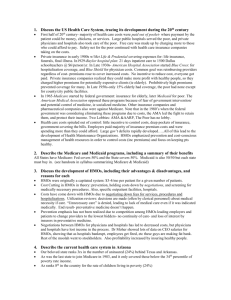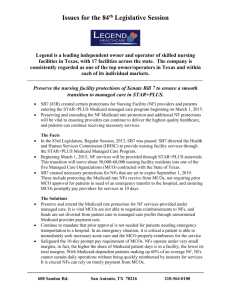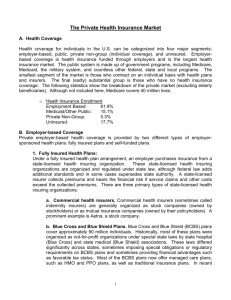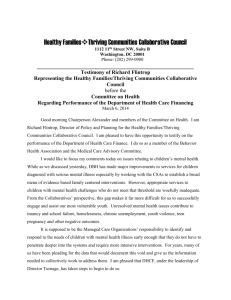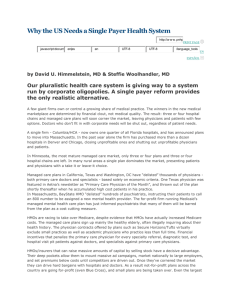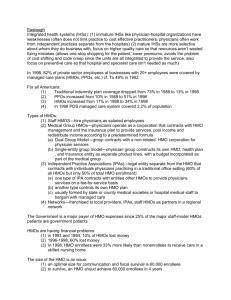Sixth Class Powerpoint Slides
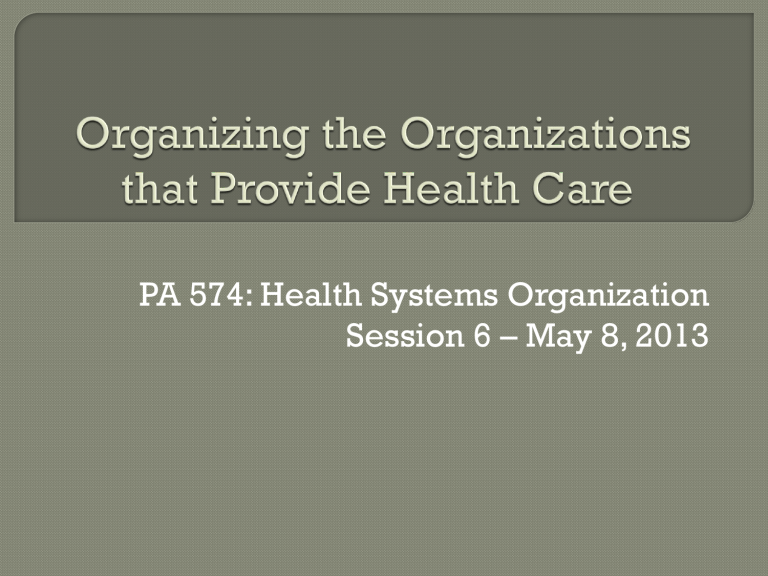
PA 574: Health Systems Organization
Session 6 – May 8, 2013
Recent history (last three plus decades) of health care reform have really been about organization (re-)structuring of the health care system
Yes about insurance and thus access – but system organization determines what you get.
“Bending the Cost Curve” and hitting the
Triple Aims really about changing how health care is delivered
•
•
•
•
Primary care medical homes are the microexample of this
This is about creating boundary spanning organization/system forms that can act like a
“rational” system.
Seeking Triple Aim capable system:
ACOs, CCOs, HMOs, MCOs – all the same thing generally
About the “right” mix of natural/rational/open
All starts with managed care – Managed Care
Organizations (MCO) or Health Maintenance
Organizations (HMOs)
Been around since mid-20 th century:
•
•
•
Kaiser-Permanente
Group Health Cooperative
Health Insurance Plan of NY
• Couple others..
Despite 1973 law supporting HMOs with tax breaks and other legal support:
•
•
In late 80’s, less than 20% population enrolled in HMOs/MCOs
• By early 90’s, more than 80% population enrolled in HMOs/MCOs
Why switch?
Intense cost/value concerns
• State law changes and anti-trust suits removed many barriers
So what is “managed care”
•
•
• Single care providing organization paid a global budget (marriage of insurance and care provision
Defined population (covered lives)
Need to provide all services (access and coordination)
•
•
• Keeping people healthy could actually make money
Voluntary enrollment (individual experience of care)
Triple Aim potential!
What are types of MCO/HMOs
Staff Model -Formal single organization where everyone is employee and everything owned by org – Group Health Cooperative
Group Model – Limited entities act as single organization through tight, longer term contractual ties – Kaiser-Permanente
Virtual Model – Several to many organizations represent as single organization through looser and more time limited contracts.
Kind of like private versions of Beveridge
Classic, to Neo-Classic, to Bismarck(??)
Did it change anything?
•
• Cost yes – actually bent the cost curve!!
Much more emphasis on prevention at all levels
•
•
• But system incentives against advertising you are good at treating ill (adverse selection)
Some but limited evidence of quality improvement
No evidence of quality loss – despite books entitled “How Managed Care Can Kill You”
So what happened?
•
•
•
•
•
• Managed care “backlash” of late 90’s
Perogatives and incomes of providers threatened
Some bad MC processes – 1-800-BEGFORCARE
Perception that MC was designed to skimp on care
(note lack of formal quality constraints despite profit incentive)
Consumers not used to “closed” systems and change not managed
“Top down” system – “bureaucrats interfering with individual care”
Managed care goes “underground” – but not gone
Ten years or so and new boundary spanning org forms start to re-appear
Birth of ACOs, CCOs, etc.
All based on general MC principles
Avoiding “top-down” and encouraging
“bottom-up” main difference
First formally introduced through CMMS under Medicare (pilots) and then into
PPACA
Affiliation of hospitals and ambulatory providers – spanning care process
Focus on reducing “downstream” intensive inpatient care
“Natural” boundaries defined:
• Patients who use hospital(s)
• Providers who refer to hospital(s)
Paid bonuses for attaining population health goals (gain sharing)
MC “light” – “natural”, voluntary affiliations, no global budget, but explicit quality targets
“Sub”-system of care – limited scope
Colorado’s Regional Coordinated Care
Organizations (RCCOs)
•
•
•
• Developed for Medicaid population
Integrates behavioral and physical care
State divided into geographic care regions
(defines “population”)
RCCO orgs formed that provide regional oversight/representation/technical assistance/monitoring but no direct authority
Primary Care Homes main underlying
“technology”
State develops a data warehouse and tech assistance unit
Explicit quality targets defined
Bonuses paid to RCCOs (and distributed?) and PCHs for improved care
All other payment (FFS) and service arrangements generally the same
Oregon’s Coordinated Care
Organizations are “next step” up.
Medicaid (OHP) also – but with eye to private
Combine physical, behavioral, dental care responsibility in one org (and wanted to include LTC)
Regional orgs with global budgets and explicit quality targets
Coordinated Care OrganizationsReplace today’s MCO/MHO/DCO system
Local health entities that deliver health care and coverage for people eligible for Medicaid (the Oregon Health Plan).
16
Local control
One point of accountability
Global (single) budget –fixed rate of growth
Expected health outcomes
Health Equity
Integrate physical and behavioral health
Community health workers
Focus on prevention
Reduced administrative overhead
Electronic health records
Patient-Centered Primary Care Homes**CCOs required to include recognized clinics in their networks of care to the maximum extent feasible
Value – improved quality at fixed cost
Health as main outcome – performance on population health rewarded
More “bottom-up”, “natural” design – attention to individual needs (consumers, providers, communities)
Voila – the Triple Aim….

